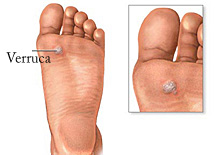Verrucae

What is a verruca? A verruca is simply a wart that is usually found on the soles of your feet, though they can also appear around the toes. In the early stages, a verruca looks like a small, dark, puncture mark but later turns grey or brown. It may become rough and bumpy with a cauliflower-like appearance and may develop a black spot in the middle, which is caused by bleeding. A verruca can grow to half an inch in diameter and may spread into a cluster of small warts.
What causes them? Verrucae are caused by the human papiloma virus (HPV). This virus is very contagious, but can only be caught by direct contact. It thrives in warm, moist environments such as swimming pools, changing room floors and bathrooms. So if an infected bare foot walks across the poolside, it may release virus-infected cells onto the floor. If you then walk on the same floor, you can pick the virus up, especially if you have any small or invisible cuts and abrasions that make it even easier for the virus to penetrate. You could also catch the virus from an infected towel.
Is it serious? verrucae can cause a sharp, burning pain if you get one on a weight-bearing area such as the ball or the heel of the foot. Because you are constantly pressing on the area when walking, they can protrude into the skin and become more painful. When you have verrucae on a non-weight-bearing surface (such as on the top of the foot or on the toes), they protrude above skin level, tend to be fleshier and cause less pain.
Who gets them? Then tend to be common in children, especially teenagers. However, for unknown reasons, some people seem to be more susceptible to the virus, whereas others are immune.
What can a podiatrist do? Because verrucae usually often disappear in time (fought off by your immune system), the general policy in the UK is to only treat them when they are causing pain. Verrucae generally resolve spontaneously within six months in children. But in adults, they can persist for years. If yours is causing pain, there are a number of treatment options available – though no one particular treatment can guarantee a cure. A recent review of treatments in the British Medical Journal (August 2002) concluded that the safest and most effective treatments were those containing salicylic acid. This acid is applied to the wart to disintegrate the viral cells and has a cure rate of 75%. It may need to be applied at weekly intervals over a set period of time.
Other treatments include: Cryotherapy This involves freezing warts off with liquid nitrogen or nitrous oxide gas. This needs to be done every 2 or 3 times before the verruca is fully removed. However, it can lead to soreness and blistering in some people. You can still swim after this treatment, but it’s not advised for sensitive or anxious children
Electrosurgery After a local anaesthetic, the verruca is pared down. A probe is then placed in the middle of the wart for a few seconds until the wart lifts – the verruca is then removed.
Excisional surgery Similar to above, but using a scalpel.
